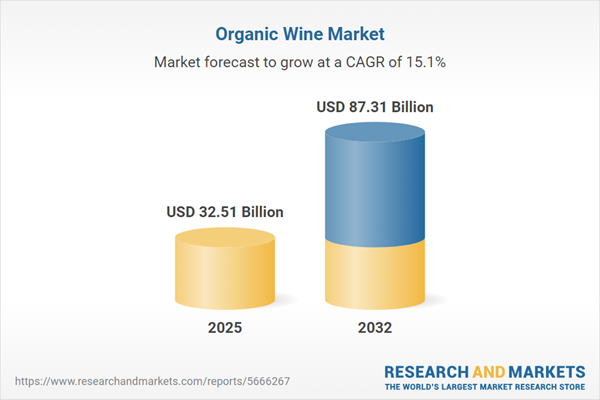Speak directly to the analyst to clarify any post sales queries you may have.
The organic wine market is reshaping the global wine industry by aligning supply chains, production, and branding with sustainability and transparency expectations. Senior leaders in wine production and distribution are prioritizing organic certification and responsible sourcing to meet evolving commercial demands and regulatory changes.
Market Snapshot: Organic Wine Market Size and Growth
The Organic Wine Market expanded from USD 28.30 billion in 2024 to USD 32.51 billion in 2025 and is projected to grow at a CAGR of 15.12%, achieving USD 87.31 billion by 2032. This rapid market acceleration underscores the shift toward responsibly produced wine, driven by increasing consumer awareness, evolving international standards, and sophisticated retail and distribution strategies that amplify reach and category influence worldwide.
Scope & Segmentation: Exploring the Organic Wine Market Landscape
This comprehensive analysis provides depth on market segmentation, technology drivers, and the international competitive environment shaping growth opportunities for stakeholders. Key segments, channels, and regions are examined to facilitate targeted strategic planning:
- Product Type: Coverage includes red, rosé, sparkling, and white wines with attention to sub-categories such as Cabernet Sauvignon, Merlot, Pinot Noir, Provence Style, Red Blend Style, Cava, Champagne, Prosecco, Chardonnay, and Sauvignon Blanc, supporting tailored product development for regional and export demands.
- Distribution Channel: Key routes comprise direct to consumer sales via cellar doors and wine clubs, digital commerce platforms through marketplaces and winery-owned sites, off-trade retail formats like grocery and supermarket, as well as on-trade placement with bars, hotels, and restaurants.
- Price Range: Marketed offerings span economy, mid-range, and premium segments, allowing for differentiated positioning and narrative-driven branding across channels and consumer segments.
- Packaging: Options include bottles, boxes, and cans, supporting emerging trends in convenience and sustainable packaging to enhance shelf visibility and consumer appeal.
- Grape Variety: Focus varietals such as Chardonnay, Merlot, Pinot Noir, and Sauvignon Blanc accommodate regional taste profiles and facilitate sourcing flexibility for producers.
- Sweetness: Products available as dry, semi-dry, and sweet, serving diverse palate and occasion preferences in established and new markets.
- Certification: Pathways encompass biodynamic and certified organic, reflecting investor and buyer expectations for verified environmental stewardship and product integrity.
- Geographic Regions: Analysis covers the Americas, Europe, Middle East, Africa, and Asia-Pacific, highlighting key trends in consumption patterns, production expansion, and regulatory changes.
- Key Companies: Profiles include E & J Gallo Winery, Constellation Brands, The Wine Group, Treasury Wine Estates, Pernod Ricard, Brown-Forman, Viña Concha y Toro, Accolade Wines, Miguel Torres, and Vintage Wine Estates, with insights into leadership, innovation, and market coverage strategies.
Key Takeaways: Strategic Insights for Senior Decision-Makers
- Demand is increasingly informed by buyers’ expectations for sustainability and transparent supply chains, supporting sector-wide adoption of environmentally certified and biodynamic practices.
- Regulatory pressures are elevating certification criteria, leading wineries to integrate advanced compliance, traceability systems, and risk management to maintain trust and protect brand assets.
- Wineries are leveraging digital technologies for direct-to-consumer models, enhancing customer engagement through virtual wine tastings, loyalty programs, and efficient digital logistics.
- Segmented positioning based on varietal, price, and channel mix enables strategic storytelling, with premium and mid-range brands using exclusive member access and targeted narrative branding.
- Collaborations with eco-focused logistics providers and specialty distributors improve end-to-end supply chain operation, supporting international expansion and local market adaptation.
- Adoption of alternative, sustainable packaging formats responds to regulatory concerns and growing consumer eco-consciousness, differentiating offerings in competitive retail spaces.
Tariff Impact: Navigating New U.S. Duties and Shifting Supply Chains
Recent United States tariff initiatives have introduced added complexity for organic wine importers, leading to market realignment and renegotiation of supplier relationships. Domestic producers are expanding organic vineyards and accelerating local production to meet growing demand. Importers are diversifying sourcing channels and logistics partnerships to remain flexible and responsive, emphasizing the necessity for adaptive procurement and resilient pricing strategies to sustain competitive advantage.
Methodology & Data Sources
This research leverages detailed interviews with vineyard operators, certification specialists, analysts, and regulators. Analysis is supported by secondary research from academic and industry sources, and advanced methods including SWOT analysis, PESTEL assessments, and scenario planning ensure actionable recommendations for sector stakeholders.
Why This Report Matters for Organic Wine Market Stakeholders
- Guides strategic planning with insights on evolving regulations, digital initiatives, and competitive strategies specific to organic wine.
- Supports decision-makers by detailing actionable recommendations on product segmentation, partnership formation, and channel optimization for growth.
- Helps industry leaders anticipate regulatory changes, capitalize on digital transformation, and strengthen supply chain resilience.
Conclusion: Strategic Roadmap for Sustainable Organic Wine Growth
The organic wine market remains dynamic and offers significant opportunities for businesses emphasizing sustainable practices, digital engagement, and collaborative supply networks. Ongoing adaptation to consumer and regulatory shifts will determine future success and leadership in the global sector.
Additional Product Information:
- Purchase of this report includes 1 year online access with quarterly updates.
- This report can be updated on request. Please contact our Customer Experience team using the Ask a Question widget on our website.
Table of Contents
3. Executive Summary
4. Market Overview
7. Cumulative Impact of Artificial Intelligence 2025
Companies Mentioned
The companies profiled in this Organic Wine market report include:- E & J Gallo Winery
- Constellation Brands, Inc.
- The Wine Group, LLC
- Treasury Wine Estates Limited
- Pernod Ricard S.A.
- Brown-Forman Corporation
- Viña Concha y Toro S.A.
- Accolade Wines Pty Ltd
- Miguel Torres S.A.
- Vintage Wine Estates, Inc.
Table Information
| Report Attribute | Details |
|---|---|
| No. of Pages | 195 |
| Published | November 2025 |
| Forecast Period | 2025 - 2032 |
| Estimated Market Value ( USD | $ 32.51 Billion |
| Forecasted Market Value ( USD | $ 87.31 Billion |
| Compound Annual Growth Rate | 15.1% |
| Regions Covered | Global |
| No. of Companies Mentioned | 11 |









